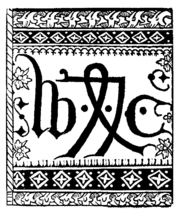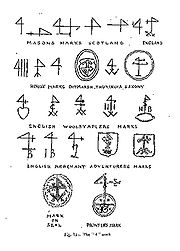
Merchant's mark
Encyclopedia


Sumer
Sumer was a civilization and historical region in southern Mesopotamia, modern Iraq during the Chalcolithic and Early Bronze Age....
that originated in the Indus Valley. Impressions of cloth, strings and other packing material on the reverse of tags with seal impressions indicate
that the Harappan seals were used to control economic administration
and trade. Amphora
Amphora
An amphora is a type of vase-shaped, usually ceramic container with two handles and a long neck narrower than the body...
e from the Roman Empire
Roman Empire
The Roman Empire was the post-Republican period of the ancient Roman civilization, characterised by an autocratic form of government and large territorial holdings in Europe and around the Mediterranean....
can sometimes be traced to their sources from the inscriptions on their handles. Commercial inscriptions in Latin
Latin
Latin is an Italic language originally spoken in Latium and Ancient Rome. It, along with most European languages, is a descendant of the ancient Proto-Indo-European language. Although it is considered a dead language, a number of scholars and members of the Christian clergy speak it fluently, and...
, known as Tituli picti
Titulus pictus
A titulus pictus is a commercial inscription made on the surface of certain artefacts . The inscription specifies information such as origin, destination, type of product, etc. Tituli picti are frequent on Roman containers used for trade....
, appear on Roman containers used for trade
Trade
Trade is the transfer of ownership of goods and services from one person or entity to another. Trade is sometimes loosely called commerce or financial transaction or barter. A network that allows trade is called a market. The original form of trade was barter, the direct exchange of goods and...
.
Symbolic merchants' marks continued to be used by artisan
Artisan
An artisan is a skilled manual worker who makes items that may be functional or strictly decorative, including furniture, clothing, jewellery, household items, and tools...
s and townspeople of the medieval and early modern eras to identify themselves and authenticate their goods. These distinctive and easily recognizable marks often appeared in their seals
Seal (device)
A seal can be a figure impressed in wax, clay, or some other medium, or embossed on paper, with the purpose of authenticating a document ; but the term can also mean the device for making such impressions, being essentially a mould with the mirror image of the design carved in sunken- relief or...
on documents and on products made for sale. They are often found on tombstones and in works of stained glass
Stained glass
The term stained glass can refer to coloured glass as a material or to works produced from it. Throughout its thousand-year history, the term has been applied almost exclusively to the windows of churches and other significant buildings...
, brass and stone, serving in place of heraldic imagery, which could not be used by the middle class
Middle class
The middle class is any class of people in the middle of a societal hierarchy. In Weberian socio-economic terms, the middle class is the broad group of people in contemporary society who fall socio-economically between the working class and upper class....
es. They were the precursors of hallmarks, printers' marks and modern-day trademarks.
To manage the risks of piracy or shipwreck, merchants often consigned a cargo to several vessels or caravans; a mark on a bale established legal ownership and avoided confusion. Early travellers, voyagers and merchants displayed their merchant's marks as well to ward off evil. Adventurous travellers and sailors ascribed the terrors and perils of their life to the wrath of the Devil
Devil
The Devil is believed in many religions and cultures to be a powerful, supernatural entity that is the personification of evil and the enemy of God and humankind. The nature of the role varies greatly...
. To counter these dangers merchants employed all sorts of religious and magical means to place their caravans, ships and merchandise under the protection of God and His Saints.

The joint stock company
Joint stock company
A joint-stock company is a type of corporation or partnership involving two or more individuals that own shares of stock in the company...
or limited liability company was another way to reduce a merchant's risks of loss of ships and merchandise from dangerous voyages and travel. By royal charter
Royal Charter
A royal charter is a formal document issued by a monarch as letters patent, granting a right or power to an individual or a body corporate. They were, and are still, used to establish significant organizations such as cities or universities. Charters should be distinguished from warrants and...
a monopoly was assured and a merchant's personal liability was limited to the amount of his own investment. If a voyage succeeded the gains accrued to all of the investors in proportion to their invested capital shares. We sometimes say, "You can pay me when your ship comes in." Modern institutions, corporations and trademarks, find some of their origins in these symbolic and legal devices for limiting physical and pecuniary risks.
The East India Company's Merchant's Mark

British East India Company
The East India Company was an early English joint-stock company that was formed initially for pursuing trade with the East Indies, but that ended up trading mainly with the Indian subcontinent and China...
was chartered by Elizabeth I, Queen of England in 1600 it was still customary for each merchant or Company of Merchant Adventurers
Company of Merchant Adventurers of London
The Company of Merchant Adventurers of London brought together London's leading overseas merchants in a regulated company, in the nature of a guild. Its members' main business was the export of cloth, especially white broadcloth...
to have a distinguishing mark which included the "Sign of Four" and served as a trademark. The East India Company's mark was made up from a '+', a '4' and the initials EIC.
This mark forms the central emblem displayed on the Scinde Dawk
Scinde Dawk
Scinde Dawk was a very old postal system of runners that served the Indus Valley of Sindh, an area of present-day Pakistan. The term also refers to the first postage stamps in Asia, the forerunners of the adhesive stamps used throughout India, Burma, the Straits Settlements and other areas...
postage stamps. Also, it was a central motif of the East India Company's coinage.
See also
- Cylinder sealCylinder sealA cylinder seal is a cylinder engraved with a 'picture story', used in ancient times to roll an impression onto a two-dimensional surface, generally wet clay. Cylinder seals were invented around 3500 BC in the Near East, at the contemporary site of Susa in south-western Iran and at the early site...
- Titulus pictusTitulus pictusA titulus pictus is a commercial inscription made on the surface of certain artefacts . The inscription specifies information such as origin, destination, type of product, etc. Tituli picti are frequent on Roman containers used for trade....
- Early modern EuropeEarly modern EuropeEarly modern Europe is the term used by historians to refer to a period in the history of Europe which spanned the centuries between the end of the Middle Ages and the beginning of the Industrial Revolution, roughly the late 15th century to the late 18th century...
- Emblems
- SealsSeal (device)A seal can be a figure impressed in wax, clay, or some other medium, or embossed on paper, with the purpose of authenticating a document ; but the term can also mean the device for making such impressions, being essentially a mould with the mirror image of the design carved in sunken- relief or...
- MonogramMonogramA monogram is a motif made by overlapping or combining two or more letters or other graphemes to form one symbol. Monograms are often made by combining the initials of an individual or a company, used as recognizable symbols or logos. A series of uncombined initials is properly referred to as a...
- Symbols
- BrandBrandThe American Marketing Association defines a brand as a "Name, term, design, symbol, or any other feature that identifies one seller's good or service as distinct from those of other sellers."...
- TrademarkTrademarkA trademark, trade mark, or trade-mark is a distinctive sign or indicator used by an individual, business organization, or other legal entity to identify that the products or services to consumers with which the trademark appears originate from a unique source, and to distinguish its products or...
- House markHouse markA House mark is a graphical figure used as a mark of recognition, that consists of simple lines with no fixed colors. A house mark is similar in appearance to pictograms and many logos....

